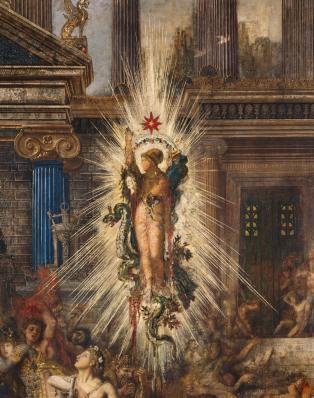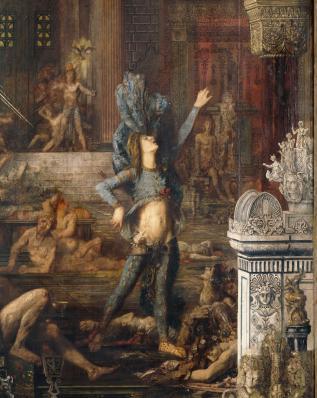Choix d'œuvres
The Suitors [Les Prétendants]
The project for The Suitors goes back to 1852, but Gustave Moreau mainly worked on it after he returned from Italy at the end of 1859. The painting, which was never completed, only reached its final size in 1882 when vertical and horizontal strips of canvas were added, the joins of which are still visible. Because of its monumental format and general composition, it was often compared with Thomas Couture’s Romans of the Decadence (Paris, Musée d’Orsay, Inv. 3451) dated 1847. It fascinated Jean Lorrain, who mentions it in chapter 31 of his novel Monsieur de Phocas published in 1901. The subject is taken from Book XXII of The Odyssey.
Ulysses, on his return to Ithaca, massacres the young princes who had been courting his wife Penelope during his absence. He is depicted holding his bow in the background of the painting, with an owl on his head, the animal attribute of Minerva. The goddess appears, towering over this scene of carnage, her body surrounded by a halo, like a Christ at the Last Judgment. In this profusion of bodies, several figures stand out: on the right, the androgynous figure of a young man dressed in blue (inspired by a classical sculpture of the god Atys, copied at the Uffizi Gallery in Florence in 1858); in the centre, a figure of the prince-poet kneeling down and leaning on a lyre personifying Phemios, the aed (singer of epic poetry), whom Ulysses spared at the request of his son Telemacus.
For Moreau: “this figure, anxious but undeterred from his poetic dream, [personifies] the young and beautiful Greece, mother of the arts and of ideas, who scorns death and defies fate.” On the left, two ephebes stoically await death: one on his knees embraces a doe, the other, seated, spear in hand, lifts a cup to his lips. The painter explains their presence thus: “The classical artists often placed these calm figures into their most dramatic paintings to rest the spirit and the eyes. […] they recall the spectator to a purely plastic beauty that is all the more beautiful for being calm. These beautiful people, tyrannical with their air of inopportuneness, draw the eyes and attention undividedly and force the spirit to prefer the contemplative immobility of the human body to its action and movement.”

![The Suitors [Les Prétendants]](/musees-napoleonien-africain/sites/moreau/files/o_cat.19.jpg)
![The Suitors [Les Prétendants]](/musees-napoleonien-africain/sites/moreau/files/2020-11/Cat.19%20D%C3%A9tail1%20Les%20pr%C3%A9tendants_0.jpg)
![The Suitors [Les Prétendants]](/musees-napoleonien-africain/sites/moreau/files/2020-11/Cat.19%20D%C3%A9tail%202%20Les%20pr%C3%A9tendants_0.jpg)


